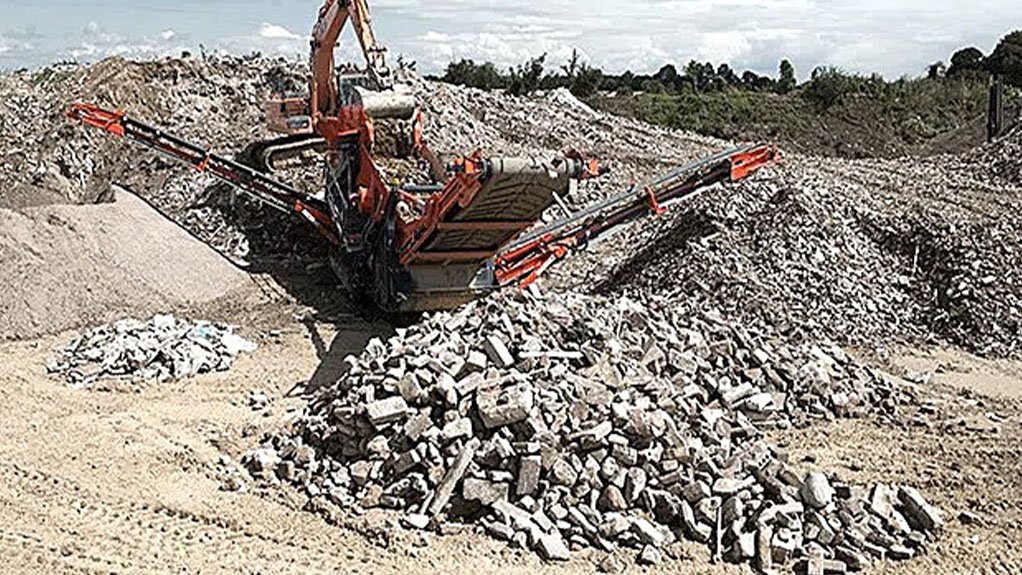Circular use of cement and concrete can provide €110bn in value
A circular economy in the concrete and cement industry could produce €110-billion in net value and avoid or mitigate two-billion tons of carbon dioxide (CO₂) emissions by 2050, driven by the capture, storage and use of CO₂ from cement and concrete production, the re-use of energy from waste material and the recirculation of materials and minerals across the built environment.
Adoption of circular technologies could also decarbonise 80% of all cement and concrete emissions by 2050, management consulting firm McKinsey's 'The Circular cement value chain: Sustainable and profitable' report projects.
Adoption of circular economy principles is estimated to offset more than half of the losses to the cement industry from rising costs and reduced demand. Adoption of circular technologies could be further accelerated by rising CO₂ prices, landfill costs and decarbonisation subsidies, the consultancy says.
Further, the report reveals that recycling and re-using construction materials and minerals alone will add nearly €80-billion a year in earnings before interest, taxes, depreciation and amortisation, while reusing concrete modules and structures will drive an estimated €24-billion of net value by 2050.
Regions with high landfill costs and significant construction and demolition waste will also reap major benefits from the use of alternative fuels from waste material, with the global average share of alternative fuels estimated to reach 43% by 2050, Mckinsey notes.
Technologies with high potential include the use of CO₂ for enhanced recarbonisation of construction and demolition waste, recycling of waste into gravel for roadbuilding, and the use of alternative fuels from energy waste.
This will be achieved by cement companies adopting circular business models such as digital marketplaces for waste and using circular technologies to react to evolving business risks in each region, McKinsey suggests.
“Applying circular economy principles to cement and concrete would not only help decarbonise the built environment, but also generate enormous economic value. The cement industry is perfectly positioned to create closed loops for CO₂, materials and minerals, and energy,” says McKinsey global energy and materials practice co-leader Jukka Maksimainen.
“We estimate each of these circular technologies will be value-positive by 2050, while some are already more profitable than today’s typical solutions. This will also drastically reduce global emissions and 30% to 40% of the world’s solid waste created through construction and maintenance of the built environment,” he highlights.
To take advantage of these opportunities, McKinsey suggests that businesses engage in circular business building. This involves embracing digital marketplaces for waste materials, using technologies that facilitate design and standardisation and creating a customer-centric circular economy businesses.
Cross-sector collaboration, meanwhile, will enable CO₂ offtake opportunities in other industries, such as using CO₂ as a feedstock for hydrogen production, the consultancy notes.
Further, businesses should use circular technologies to react to the evolving financial risks, including building cost-benefit positions based on locally varying CO₂ prices, landfill costs and regulatory frameworks and the amount of waste material available in each region.
Companies should also ensure that offtake agreements are available for circular products in each country, such as the 100 construction companies across ten countries that recently joined the United Nations Race to Zero campaign, McKinsey adds.
“Cement and other industry players should engage in circular business building and use circular technologies to react to evolving financial risks. The total value at risk from rising CO₂ prices and landfill costs could reach approximately €210-billion by 2050 and this will significantly accelerate uptake of circular technologies,” adds McKinsey global energy and materials practice partner Sebastian Reiter.
“For example, our research shows that technologies using CO₂, such as curing readymix or precast concrete, can create positive economic value, while using construction waste as aggregates for concrete production, avoids landfill costs.”
CONCRETE RE-USE
The use of recycled concrete as a construction material could reduce the CO₂ emissions of concrete, as well as lower the depletion of natural resources and dumping of concrete at landfill sites, industry organisation Cement & Concrete South Africa (CCSA) concurs.
“Recycled concrete can be used as aggregate for building products, such as bricks, blocks, layer works in road construction or land reclamation, thereby reducing the amount of material sent to landfills. This recycling also reduces the need for new virgin materials, thereby saving resources and the energy required to process them,” says CCSA CEO Bryan Perrie.
The demolition of in-situ, precast and tilt-up reinforced concrete can be achieved relatively easily using modern, cutting, breaking and lifting equipment. Once demolition of post-tensioned concrete has been completed, the concrete and reinforcing steel can be separated for recycling, he notes.
Additionally, at readymix concrete plants, wash water can be collected and reused in fresh concrete, and aggregate from returned concrete can be screened out and reused to reduce the amount of waste generated at the plants.
Further, precast components from structures should also be considered for re-use in new buildings instead of simply demolishing and recycling the concrete. Structures using precast elements can be designed for such re-use, he highlights.
“The durability of concrete structures is a key factor in their suitability for re-use. The architect or designer needs to apply many different strategies to ensure the structure is sustainable in terms of its environmental and social impact, and minimises use of energy, water and the generation of waste during the life cycle of the building.
“All of this can only be assessed by carrying out a full life-cycle assessment of the structure,” he adds.
Recycled concrete has a significant role to play in creating a sustainable and ecologically responsible built environment. When a building reaches its end of life, the order of decision-making should firstly be to re-use the building, re-use the components or, as a last resort, demolish it and recycle the materials.
“Recycled concrete aggregate made from crushed concrete has proved viable and makes economic and ecological sense. As a coarse aggregate, it is particularly appropriate as bedding material, concrete roads and pavements, floors, reinforced concrete, precast and masonry elements, and foundations,” Perrie emphasises.
Further, tests have shown that using the recycled materials leads to an 80% reduction in CO2 compared with new concrete mixes, with a 75% embodied energy reduction.
“Transport costs for aggregates continue to increase, whereas recycled aggregate is generally closer and more readily available,” he notes.
Article Enquiry
Email Article
Save Article
Feedback
To advertise email advertising@creamermedia.co.za or click here
Comments
Press Office
Announcements
What's On
Subscribe to improve your user experience...
Option 1 (equivalent of R125 a month):
Receive a weekly copy of Creamer Media's Engineering News & Mining Weekly magazine
(print copy for those in South Africa and e-magazine for those outside of South Africa)
Receive daily email newsletters
Access to full search results
Access archive of magazine back copies
Access to Projects in Progress
Access to ONE Research Report of your choice in PDF format
Option 2 (equivalent of R375 a month):
All benefits from Option 1
PLUS
Access to Creamer Media's Research Channel Africa for ALL Research Reports, in PDF format, on various industrial and mining sectors
including Electricity; Water; Energy Transition; Hydrogen; Roads, Rail and Ports; Coal; Gold; Platinum; Battery Metals; etc.
Already a subscriber?
Forgotten your password?
Receive weekly copy of Creamer Media's Engineering News & Mining Weekly magazine (print copy for those in South Africa and e-magazine for those outside of South Africa)
➕
Recieve daily email newsletters
➕
Access to full search results
➕
Access archive of magazine back copies
➕
Access to Projects in Progress
➕
Access to ONE Research Report of your choice in PDF format
RESEARCH CHANNEL AFRICA
R4500 (equivalent of R375 a month)
SUBSCRIBEAll benefits from Option 1
➕
Access to Creamer Media's Research Channel Africa for ALL Research Reports on various industrial and mining sectors, in PDF format, including on:
Electricity
➕
Water
➕
Energy Transition
➕
Hydrogen
➕
Roads, Rail and Ports
➕
Coal
➕
Gold
➕
Platinum
➕
Battery Metals
➕
etc.
Receive all benefits from Option 1 or Option 2 delivered to numerous people at your company
➕
Multiple User names and Passwords for simultaneous log-ins
➕
Intranet integration access to all in your organisation





















